These days we are inundated with information on how to manage our performance horse, geriatric horse, and what ever, usually from the companies that sell supplements. If there is a problem with your horse, there is probably a supplement designed for it.
![Sharif paying attention to work done on his neck. [Catherine Sobredo Photography]](https://horsesatliberty.files.wordpress.com/2012/08/imgp2293.jpg?w=198)
[Catherine Sobredo Photography]
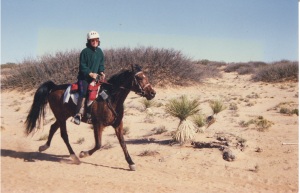 We are supplementing largely because most of our horses don’t get enough free roaming exercise and they don’t get to forage naturally. Horses in herds take care of themselves
We are supplementing largely because most of our horses don’t get enough free roaming exercise and they don’t get to forage naturally. Horses in herds take care of themselves
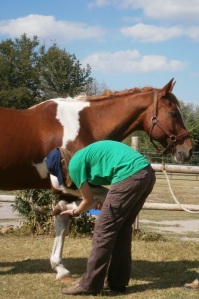
and each other to a large extent. This isn’t a rule necessarily; they still may get injured or attacked by predators, they may get in fights within the herd, but they don’t get in trailer accidents, rarely colic and probably don’t get diseases like laminitis and Cushings, and insulin resistance, even though they might be eating rich grasses. The moving body shifts nutrients where they need to go. The herd dynamic helps maintain health for the whole herd body, nourishing the individuals who have problems so they can keep up with the herd.
Systemic illnesses stem largely from lifestyles for horses. At barns it is common to have tubs full of supplements in powder and pre-packaged supplements, bins full of processed grains. It is also common for those in performance to have their hocks and other joints injected regularly. Adequan injections (intra-muscular) are also popular, but that is a $90/month+ expense. Nutraceuticals such as chondroitan supplements are also popular, but their efficacy has not been proven, even though vets recommend them liberally.
I’ve been at barns where the owners become frantic if they can’t exercise or have their horse exercised every day. And rightly so, a horse that stands around isn’t going to remain healthy for long. But what horses really need is the ability to roam around, have interesting grasses to find, the world they are designed for. Centuries of evolution have shaped the horse into the being she is, with feet that contact the ground and can feel movements in the earth, and other animals approaching, a highly developed sensory system, and a high sensitivity to their environment. With training a lot of these traits can end up taking a back seat, because we don’t want a flighty, reactive horse, we want one that sticks with us. Some horses have been so highly bred for a specific man-made purpose that the environment of a herd and free roaming might even make them nervous!
I’m suggesting here that there is a better, less costly way to keep horses, even if you don’t have a lot of space to keep them.
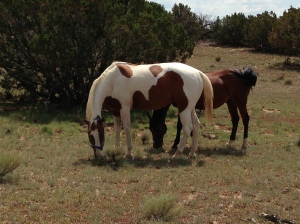 Because horses are not generally kept naturally, they can benefit from receiving bodywork. Even horses who are kept naturally are for the most part not kept in really large herds and can use some assistance with bodywork. The body can benefit from addtional support for organs, circulation, structure, muscles, fascia – all areas of anatomy and physiology. Horses in training in particular can gain great benefit from this additional support. This doesn’t always happen however, because it may conflict with the training program, and in many cases, when a horse has difficulty doing something, the belief is that you keep trying it and eventually the horse will get better at it. This is only going to work if the horse doesn’t have a physical problem doing the activity required. When a horse can’t pick up a canter, or has a lameness, it’s a good time to consider bodywork, in addition to regular veterinary support, whether he is a performance horse or not.
Because horses are not generally kept naturally, they can benefit from receiving bodywork. Even horses who are kept naturally are for the most part not kept in really large herds and can use some assistance with bodywork. The body can benefit from addtional support for organs, circulation, structure, muscles, fascia – all areas of anatomy and physiology. Horses in training in particular can gain great benefit from this additional support. This doesn’t always happen however, because it may conflict with the training program, and in many cases, when a horse has difficulty doing something, the belief is that you keep trying it and eventually the horse will get better at it. This is only going to work if the horse doesn’t have a physical problem doing the activity required. When a horse can’t pick up a canter, or has a lameness, it’s a good time to consider bodywork, in addition to regular veterinary support, whether he is a performance horse or not.
I began my interest in bodywork from the standpoint of an endurance rider. I was riding several times a week, competing once every two months, and I had to see a bodyworker once every two weeks and exercise to keep up with that. I used to maintain my endurance horses on a natural feed of oats, barley and corn without molasses, and a vitamin supplement. I was getting bodywork for my horse (and for myself) frequently and I figured, I should learn how to do this myself.
Of course, taking the courses were probably more expensive than just hiring someone else to do the bodywork, but I wanted to learn more about the body and what its needs were. I chose Ortho-Bionomy out of a lot of courses offered at the Healing Arts Academy in Santa Fe, because the description resonated with me. In doing so, I also learned to work on people, which is wonderful because now, having a practice where I can work on both people and horses, and work on them together in some cases, helps inform the work I do as a whole and individually.
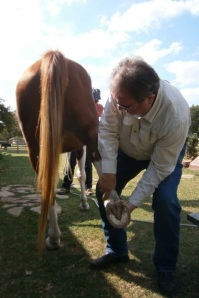
While I’m not suggesting that everyone run out and become a bodyworker, there are techniques you can learn to help take care of your own horse. Once I began to take care of my own horse and see how I could avert costly vet bills except in cases of extreme illness or injury, I began to look at lower cost ways of taking care of my horse and explored natural remedies as well. Practices and products that I used to buy, I no longer have to buy. Natural remedies can also provide wonderful nutritional support during acute phases of illness and can keep a horse healthy with better results in many cases than pharmaceuticals and pre-packaged products. Spending $13 a month on herbs may take a little more time than pressing “Order” online where you can be spending $80-plus on a couple of pre-packaged supplements monthly, but to me it’s well worth it.
I also make a hoof oil that can be applied to the hooves of horses with laminitis, Cushings and other metabolic disorders. It is also good for just keep the hoof lubricated especially in dry climates like New Mexico.
What I have found is that I don’t have to put my horses on nutraceuticals, digestive aids, behavioral supplements, get hock injections, or use pharmaceutical drugs at this time. It doesn’t mean that I wouldn’t ever use these products; if I found it necessary, I would, and definitely would need veterinary support in cases of extreme injury or illness. I have two geriatric horses, one young horse and a middle-aged horse with some physical challenges and they do fine with bodywork, herbs and alternative remedies. All of them are sound and are ridden to varying degrees regularly, depending upon their ages and abilities. I know that for at least two of them, I could take them out and do a limited distance ride with some legging up, with no additional nutritional support. Those would be my 21-year-old and 10-year-old mares. If I wanted to do more distance, I would of course train more vigorously, both for myself and horse, and I would basically just add more groceries.
Here’s another fact: Drylands take up 41.3% of the land surface of the earth and are quickly degrading. Up to 44% of all the world’s cultivated systems are in the drylands. Plant species endemic to the drylands make up 30% of the plants under cultivation today. Their ancestors and wild relatives still grow here. Traditionally, drylands have been largely used for livestock, but they are increasingly being converted into cropland. Rangelands support 50% of the world’s livestock and are habitats for wildlife. Livestock production is dominant in the more arid zones. Cropland dominates in the dry sub-humid areas.*
With this in mind, we know we can’t sustain our horses on large acreages into the future, unless we help the land to become more sustainable. The land that horses could once roam on now doesn’t have the trace minerals in it that it once had, so therefore the grasses are not as nutritious as they once were. Yet they are better than nothing and the opportunity to graze, which is most natural to horses, is best for them if we can provide it. In lieu of this idyllic situation, setting up slow feed haynets and feeders at varying locations is a good way to provide continuous food that the horse can’t gorge on, which is best for the horse’s gut as well as movement from place to place. Joe Camp has written books about his and his wife’s ability to maintain horses on a small acreage, good reading by the way. Providing herbs is another very valuable alternative. Herbs are a centuries-old healing medicine, and where all our modern medicines come from, and can address every one of the ailments we scan our horse catalogs to treat, but they come without the side-effects that you receive from taking most pharmaceutical drugs.
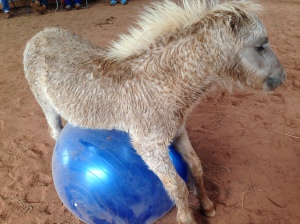
If you are interested in putting together a more natural program for your performance horse, geriatric horse, backyard riding horse or donkey or mule, do contact me for more information. This type of program will in no way be a replacement for veterinary care. It could be used to complement it where needed. I will also be offering three-hour OrthoHorse Tutorials for those who want to learn bodywork for their own horses.
Services: Bodywork (Ortho-Bionomy for people, Equine Positional Release/Equine Ortho-Bionomy): private sessions, tutorials, phone consultations, distance healing communication and gift certificates
Liberty Training: clinics, mini-clinics, workshops, private and semi-private sessions, tutorials, consultations: by appointment: 505.501.2478 or emailing susansmith@orthohorse.info
Fall Lessons – semi-private, private and small group sessions. Scheduling now. We have small groups and privates scheduled for Santa Fe, Corrales and El Dorado currently. Contact me for details.
OrthoHorse Tutorials and Horses at Liberty Foundation Training Clinics will be offered on the 2014 schedule.
Fascinating article on Ortho-Bionomy: Better than a pain pill? PostIndependent.com
Copyright (c) Susan Smith, OrthoHorse, Horses at Liberty Foundation Training
*United Nations Decade – 2010-2020



This hits the nail on the head, Susan. And it seems especially challenging to keep a performance horse in tip-top shape naturally. Check out Dr. Madalyn Ward’s Kindle book, “How to Have A Holistically Healthy Performance Horse.” She’s a holistic equine vet in Texas, and this book really targets those folks whose performance horses are working regularly. http://www.amazon.com/HOLISTICALLY-HEALTHY-PERFORMANCE-HORSE-ebook/dp/B00CH9ERJW/ref=sr_1_1?s=digital-text&ie=UTF8&qid=1383435033&sr=1-1&keywords=Madalyn+Ward
Dr. Ward’s books are fantastic, Leta and I’m glad you mentioned the one on having a “Holistic Performance Horse.”